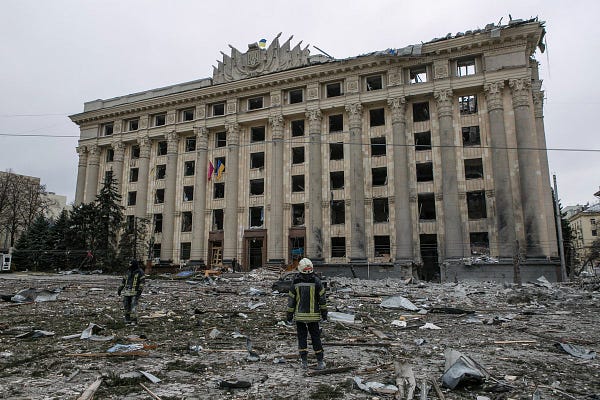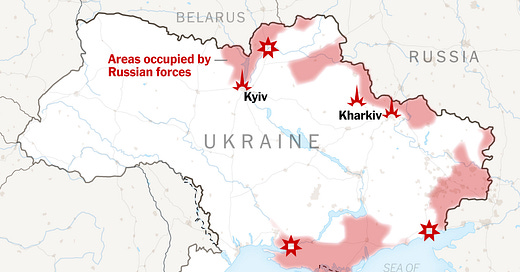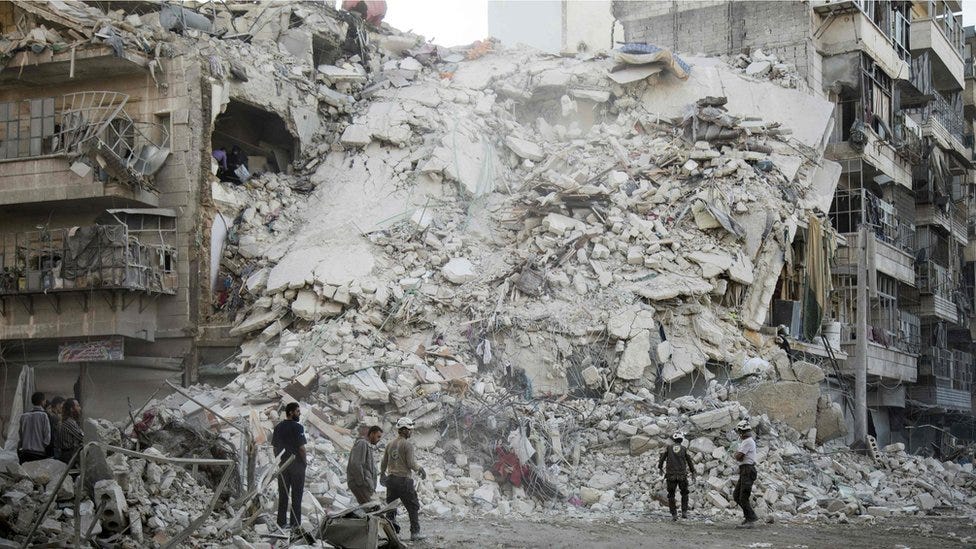Dispatch 006: Geography, Vacuum Bombs and The World's First Live Streamed War
How geographic realities impact social, economic and military realities in Eastern Europe; The changing tactics of Russia's invasion; Twitter War and More.
Americans Suck At Geography, But Not You
If you knew where Ukraine was prior to the start of the Russian invasion last week, you would probably find yourself in the upper echelon of geographically savvy Americans.
Americans don’t do geography well - call it a quirk of growing up thinking you’re the world’s sole super power. But, geographic realities usually dictate the social, political and economic realities that we see lived out today.
Here’s a small crash course in the geographic challenges facing this regions’ major players ↓
Russia
Geopolitical goal: Be so big no power can destroy you and accomplish this through the acquisition of buffer states like Belarus and Ukraine.
Belarus is able to be controlled through economics and corruption, and, when Ukraine showed an inability to be controlled through these levers, Russia resorted to hard military power.
Ukraine
Geopolitical Challenge: How to balance Russia’s economic, cultural and historical influence over itself with its European Union and Westward aspirations.
Anytime Ukraine has swung too far West, Moscow has deployed its security service, corruption and hybrid warfare to bring it back East:
2010 Pro Western former president of Ukraine jailed in favor of Kremlin crony.
2014 Hybrid war in Ukraine’s eastern Donbas region.
2022 Conventional War to stop EU/NATO membership.
Belarus
While recent events clearly show Belarus’s government opted for alignment with Moscow, Belarus’s core challenge is deciding whether it is actually it’s own country or a Russian puppet state.
Psst - It’s a puppet state.
Poland
Poland is geographically flat with no natural defenses.
Figuring out how to draw in other former USSR members like Ukraine into the EU and NATO while making sure Germany, France and Britain see Russia as a credible threat is its core challenge.
Poland has had its heaviest losses inflicted upon it by Russia in, WWI, WWII and served as a USSR puppet state during the Cold War. To say Poland has a sharp fear of Russian aggression would be an understatement. This is probably why Poland has been the most aggressive EU/NATO member in supplying Ukraine with weapons. Better to fight Russia in Ukraine than fight Russia at home.
The Changing Tactics of Russia’s Invasion
Logistically, the first days of the Russian invasion were a logistical mess. Over stretched supply lines, a lack of fuel, lack of coordination, and a general lack of even an awareness by Russia’s conscripts as to what they were doing in Ukraine combined to present the much lauded revamped Russian military as - well - a shit show.
Combine this with the Ukrainian Arm Forces’ successful defense of their cities, social media blitz and incredibly high morale and the early days of the invasion did not go as planned.
But, it has become apparent in the past few days that Russia is shifting tactics from precision strikes with smaller special forces units to indiscriminate bombardment of civilian populations.
If you’d like a clue as to what the next few days hold for Ukraine, look at Russia’s involvement in leveling the Syrian city of Aleppo on behalf of Syrian dictator Bashar Assad.
The UN and Doctors Without Borders even stopped providing the Russian military with its humanitarian positions when they found out the Russians were utilizing them as bombing targets.
With the US withdrawing from supporting Syria’s Kurds Russia was given a green light to field test their modern weaponry on live civilian targets, much in the same way Hitler and the SS used the 1930s Spanish Civil War as their proving grounds for their blitzkrieg tactics.
Nowhere have Russia’s tactics been more lethal and horrifying than in Ukraine’s second city, Kharkiv.



There are a lot more horrifying images and video of these attacks online, but there’s no moral victory in showing them here. Just know that most of the people doing the dying right now are children and civilians.
Most disturbing have been reports of vacuum bombs designed to suck air so forcefully out of a blast zone that it will literally rip its victims’ lungs from the inside out in their last moments before subsequently being vaporized in a ball of fire.
(Ironically, the US pioneered the use of these weapons in the Vietnam War, and it was because we used them so much that the Geneva Convention on Human Rights prohibits their use on civilian populations…but I digress)
There have been reports of the Russian military announcing the opening of “civilian corridors” for Ukrainians to flee from cities like Kharkiv, Mariupol and Kherson where the most intense fighting is occurring.
But, if we are to use Russia’s involvement in Syria as any guide for what this means, Russia announced opening civilian corridors to the people of Aleppo before they leveled it.
The initial phases of the Russian invasion seem to be drawing to a close and a new, bloodier, second phase is likely beginning consisting of close-quarters urban warfare and more indiscriminate Russian bombardments.
War in 280 Characters
WWII was awful, but could you imagine it live streamed on TikTok and Twitter?
The Ukrainian - Russian War is turning into the world’s first live streamed conventional war.
If you’ve got a spare minute (or ate a bunch of bad Chinese food and you’ll be on the John for a while) I think this piece by David Patrikarakos in Unherd is one of the few placed talking about the impact Ukraine’s successful information war is having on this conflict.
He also wrote a great book War In 140 Characters How Social Media Is Reshaping Conflict in the Twenty-First Century based on his years embedded with Russian-backed separatists in Ukraine’s Donbas and the Ukrainian Army fighting them in 2014.






